Android 16 introduce nuove funzionalità e API straordinarie per gli sviluppatori. Le sezioni seguenti riepilogano queste funzionalità per aiutarti a iniziare a utilizzare le API correlate.
Per un elenco dettagliato delle API nuove, modificate e rimosse, leggi il report sulle differenze delle API. Per informazioni dettagliate sulle nuove API, consulta il riferimento API Android: le nuove API sono evidenziate per una maggiore visibilità.Devi anche esaminare le aree in cui le modifiche alla piattaforma potrebbero influire sulle tue app. Per maggiori informazioni, consulta le seguenti pagine:
- Modifiche del comportamento che interessano le app quando hanno come target Android 16
- Modifiche al comportamento che interessano tutte le app indipendentemente da
targetSdkVersion.
Funzionalità di base
Android include nuove API che espandono le funzionalità di base del sistema Android.
Due release dell'API Android nel 2025
- This preview is for the next major release of Android with a planned launch in Q2 of 2025. This release is similar to all of our API releases in the past, where we can have planned behavior changes that are often tied to a targetSdkVersion.
- We're planning the major release a quarter earlier (Q2 rather than Q3 in prior years) to better align with the schedule of device launches across our ecosystem, so more devices can get the major release of Android sooner. With the major release coming in Q2, you'll need to do your annual compatibility testing a few months earlier than in previous years to make sure your apps are ready.
- We plan to have another release in Q4 of 2025 which also will include new developer APIs. The Q2 major release will be the only release in 2025 to include planned behavior changes that could affect apps.
In addition to new developer APIs, the Q4 minor release will pick up feature updates, optimizations, and bug fixes; it will not include any app-impacting behavior changes.

We'll continue to have quarterly Android releases. The Q1 and Q3 updates in-between the API releases will provide incremental updates to help ensure continuous quality. We're actively working with our device partners to bring the Q2 release to as many devices as possible.
Using new APIs with major and minor releases
Guarding a code block with a check for API level is done today using
the SDK_INT constant with
VERSION_CODES. This will continue
to be supported for major Android releases.
if (SDK_INT >= VERSION_CODES.BAKLAVA) {
// Use APIs introduced in Android 16
}
The new SDK_INT_FULL
constant can be used for API checks against both major and minor versions with
the new VERSION_CODES_FULL
enumeration.
if (SDK_INT_FULL >= VERSION_CODES_FULL.[MAJOR or MINOR RELEASE]) {
// Use APIs introduced in a major or minor release
}
You can also use the
Build.getMinorSdkVersion()
method to get just the minor SDK version.
val minorSdkVersion = Build.getMinorSdkVersion(VERSION_CODES_FULL.BAKLAVA)
These APIs have not yet been finalized and are subject to change, so please send us feedback if you have any concerns.
Esperienza utente e interfaccia utente di sistema
Android 16 offre agli sviluppatori di app e agli utenti maggiore controllo e flessibilità per configurare il proprio dispositivo in base alle proprie esigenze.
Notifiche incentrate sull'avanzamento
Android 16 introduces progress-centric notifications to help users seamlessly track user-initiated, start-to-end journeys.
Notification.ProgressStyle is a new notification
style that lets you create progress-centric notifications. Key use cases include
rideshare, delivery, and navigation. Within the Notification.ProgressStyle
class, you can denote states and milestones in a user journey using
points and segments.
To learn more, see the Progress-centric notifications documentation page.
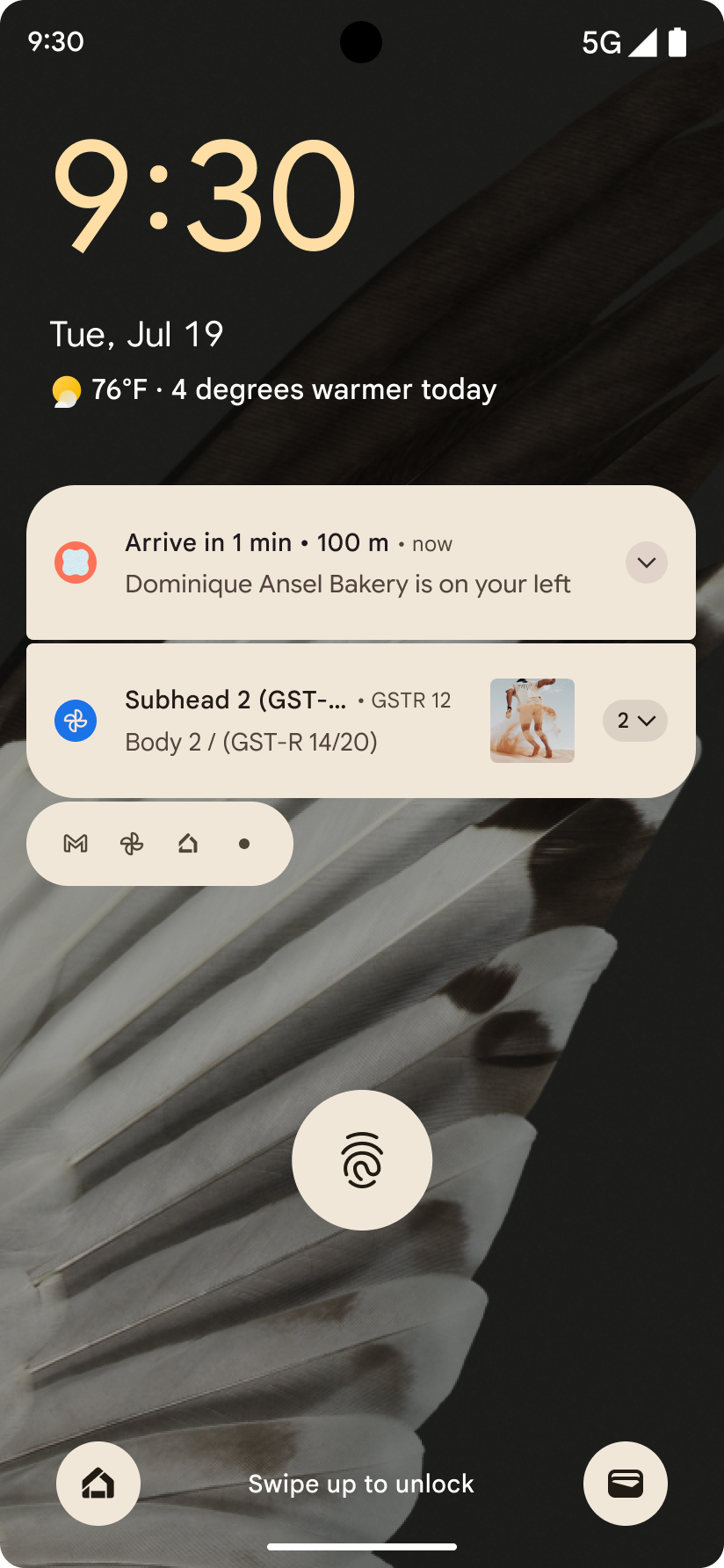
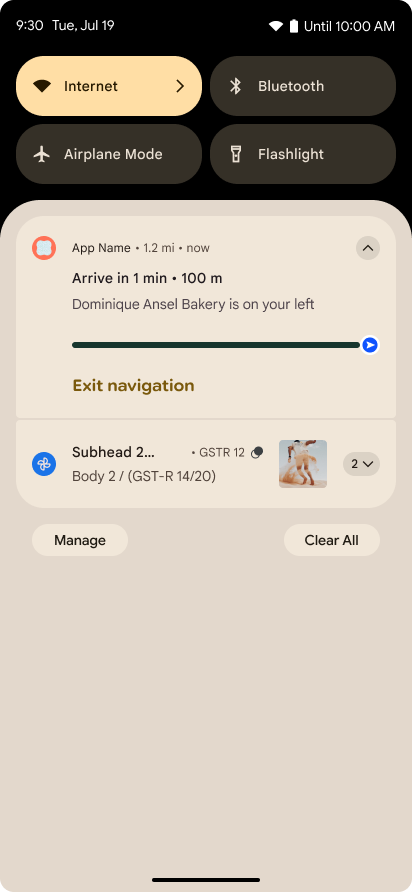
Aggiornamenti del gesto Indietro predittivo
Android 16 adds new APIs to help you enable predictive back system animations in
gesture navigation such as the back-to-home animation. Registering the
onBackInvokedCallback with the new
PRIORITY_SYSTEM_NAVIGATION_OBSERVER allows your app to
receive the regular onBackInvoked call whenever the
system handles a back navigation without impacting the normal back navigation
flow.
Android 16 additionally adds the
finishAndRemoveTaskCallback() and
moveTaskToBackCallback. By registering these callbacks
with the OnBackInvokedDispatcher, the system can trigger
specific behaviors and play corresponding ahead-of-time animations when the back
gesture is invoked.
Feedback aptico più completo
Android ha esposto il controllo sull'attuatore aptico fin dalla sua nascita.
Android 11 ha aggiunto il supporto di effetti aptico più complessi che gli attuatori più avanzati potrebbero supportare tramite
VibrationEffect.Compositions di primitive semantiche predefinite dal dispositivo.
Android 16 aggiunge API aptica che consentono alle app di definire le curve di ampiezza e frequenza di un effetto aptico, rimuovendo al contempo le differenze tra le funzionalità dei dispositivi.
Produttività e strumenti per sviluppatori
Sebbene la maggior parte del nostro lavoro per migliorare la produttività si basi su strumenti come Android Studio, Jetpack Compose e le librerie Android Jetpack, cerchiamo sempre modi per aiutarti a realizzare la tua visione all'interno della piattaforma.
Gestione dei contenuti per gli sfondi animati
In Android 16, il framework degli sfondi animati acquisirà una nuova API per i contenuti per rispondere alle sfide degli sfondi dinamici basati sugli utenti. Al momento, gli sfondi animati che incorporano contenuti forniti dagli utenti richiedono implementazioni complesse e specifiche per i servizi. Android 16 introduce
WallpaperDescription e
WallpaperInstance. WallpaperDescription consente di identificare istanze distinte di uno sfondo animato dello stesso servizio. Ad esempio, uno sfondo che ha istanze sia nella schermata Home sia nella schermata di blocco può avere contenuti unici in entrambe le posizioni. Il selettore di sfondi e
WallpaperManager utilizzano questi metadati per presentare meglio
gli sfondi agli utenti, semplificando la procedura per creare esperienze diverse e personalizzate con gli sfondi animati.
Prestazioni e batteria
Android 16 introduce API che consentono di raccogliere informazioni sulle tue app.
Profilazione attivata dal sistema
ProfilingManager è stato
aggiunto in Android 15, consentendo alle app di
richiedere la raccolta dei dati di profilazione utilizzando Perfetto su dispositivi pubblici sul campo.
Tuttavia, poiché questa profilazione deve essere avviata dall'app, i flussi critici come le startup o gli ANR sarebbero difficili o impossibili da acquisire per le app.
Per aiutarti, Android 16 introduce il profiling attivato dal sistema in ProfilingManager. Le app possono registrare l'interesse a ricevere tracce per determinati attivatori, come l'avvio a freddo reportFullyDrawn o gli ANR, dopodiché il sistema avvia e interrompe una traccia per conto dell'app. Al termine della traccia, i risultati vengono inviati alla directory dei dati dell'app.
Avvia il componente in ApplicationStartInfo
ApplicationStartInfo was added in Android
15, allowing an app to see reasons
for process start, start type, start times, throttling, and other useful
diagnostic data. Android 16 adds
getStartComponent()
to distinguish what component type triggered the start, which can be helpful for
optimizing the startup flow of your app.
Migliore introspezione dei job
L'API JobScheduler#getPendingJobReason() restituisce il motivo per cui un job potrebbe essere in attesa. Tuttavia, un job potrebbe essere in attesa per più motivi.
In Android 16, stiamo introducendo una nuova API
JobScheduler#getPendingJobReasons(int jobId), che restituisce più
motivi per cui un job è in attesa, sia a causa di vincoli espliciti impostati dall' sviluppatore sia di vincoli impliciti impostati dal sistema.
Stiamo anche introducendo
JobScheduler#getPendingJobReasonsHistory(int jobId), che restituisce un elenco
delle modifiche ai vincoli più recenti.
Ti consigliamo di utilizzare l'API per aiutarti a eseguire il debug del motivo per cui i job potrebbero non essere eseguiti, soprattutto se riscontri tassi di successo ridotti di determinate attività o hai bug relativi alla latenza del completamento di determinati job. Ad esempio, l'aggiornamento dei widget in background non è andato a buon fine o non è stato possibile chiamare il job di pre-caricamento prima dell'avvio dell'app.
In questo modo puoi anche capire meglio se determinati job non vengono completati a causa di vincoli definiti dal sistema rispetto a vincoli impostati esplicitamente.
Frequenza di aggiornamento adattiva
Adaptive refresh rate (ARR), introduced in Android 15, enables the display refresh rate on supported hardware to adapt to the content frame rate using discrete VSync steps. This reduces power consumption while eliminating the need for potentially jank-inducing mode-switching.
Android 16 introduces hasArrSupport() and
getSuggestedFrameRate(int) while restoring
getSupportedRefreshRates() to make it easier for your apps to take
advantage of ARR. RecyclerView
1.4 internally supports ARR when it is settling from a fling or
smooth scroll, and we're continuing our work to add ARR
support into more Jetpack libraries. This frame rate article covers
many of the APIs you can use to set the frame rate so that your app can directly
use ARR.
API Headroom in ADPF
The SystemHealthManager introduces the
getCpuHeadroom and
getGpuHeadroom APIs, designed to provide games and
resource-intensive apps with estimates of available CPU and GPU resources. These
methods offer a way for you to gauge how your app or game can best improve
system health, particularly when used in conjunction with other Android Dynamic
Performance Framework (ADPF) APIs that detect thermal
throttling.
By using CpuHeadroomParams and
GpuHeadroomParams on supported devices, you can
customize the time window used to compute the headroom and select between
average or minimum resource availability. This can help you reduce your CPU or
GPU resource usage accordingly, leading to better user experiences and improved
battery life.
Accessibilità
Android 16 aggiunge nuove API e funzionalità di accessibilità che possono aiutarti a portare la tua app a ogni utente.
API di accessibilità migliorate
Android 16 adds additional APIs to enhance UI semantics that help improve consistency for users that rely on accessibility services, such as TalkBack.
Outline text for maximum text contrast
Users with low vision often have reduced contrast sensitivity, making it challenging to distinguish objects from their backgrounds. To help these users, Android 16 introduces outline text, replacing high contrast text, which draws a larger contrasting area around text to greatly improve legibility.
Android 16 contains new AccessibilityManager APIs to let
your apps check or register a listener to
see if this mode is enabled. This is primarily for UI Toolkits like Compose to
offer a similar visual experience. If you maintain a UI Toolkit library or your
app performs custom text rendering that bypasses the
android.text.Layout class then you can use this to know
when outline text is enabled.
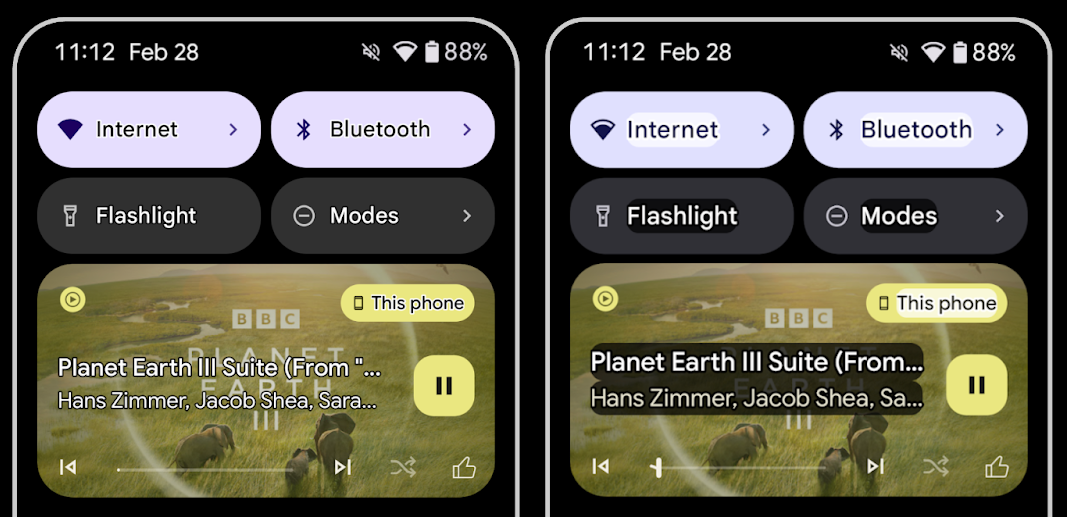
Duration added to TtsSpan
Android 16 extends TtsSpan with a TYPE_DURATION,
consisting of ARG_HOURS, ARG_MINUTES,
and ARG_SECONDS. This lets you directly annotate time
duration, ensuring accurate and consistent text-to-speech output with services
like TalkBack.
Support elements with multiple labels
Android currently allows UI elements to derive their accessibility label from
another, and now offers the ability for multiple labels to be associated, a
common scenario in web content. By introducing a list-based API within
AccessibilityNodeInfo, Android can directly support these
multi-label relationships. As part of this change, we've deprecated
AccessibilityNodeInfo#setLabeledBy and
#getLabeledBy in favor of
#addLabeledBy, #removeLabeledBy, and
#getLabeledByList.
Improved support for expandable elements
Android 16 adds accessibility APIs that allow you to convey the expanded or
collapsed state of interactive elements, such as menus and expandable lists. By
setting the expanded state using setExpandedState and
dispatching TYPE_WINDOW_CONTENT_CHANGED AccessibilityEvents
with a CONTENT_CHANGE_TYPE_EXPANDED content change type,
you can ensure that screen readers like TalkBack announce
state changes, providing a more intuitive and inclusive user experience.
Indeterminate ProgressBars
Android 16 adds RANGE_TYPE_INDETERMINATE, giving a way for
you to expose RangeInfo for both determinate and
indeterminate ProgressBar widgets, allowing services like
TalkBack to more consistently provide feedback for progress
indicators.
Tri-state CheckBox
The new AccessibilityNodeInfo
getChecked and setChecked(int)
methods in Android 16 now support a "partially checked" state in addition to
"checked" and "unchecked." This replaces the deprecated boolean
isChecked and setChecked(boolean).
Supplemental descriptions
When an accessibility service describes a ViewGroup, it
combines content labels from its child views. If you provide a
contentDescription for the ViewGroup, accessibility services assume you are
also overriding the description of non-focusable child views. This can be
problematic if you want to label things like a drop-down (for example, "Font
Family") while preserving the current selection for accessibility (for example,
"Roboto"). Android 16 adds setSupplementalDescription so
you can provide text that provides information about a ViewGroup without
overriding information from its children.
Required form fields
Android 16 adds setFieldRequired to
AccessibilityNodeInfo so apps can tell an accessibility
service that input to a form field is required. This is an important scenario
for users filling out many types of forms, even things as simple as a required
terms and conditions checkbox, helping users to consistently identify and
quickly navigate between required fields.
Smartphone come input microfono per le chiamate vocali con apparecchi acustici LEA
Android 16 consente agli utenti di apparecchi acustici LE Audio di passare tra i microfoni integrati sugli apparecchi acustici e il microfono sullo smartphone per le chiamate vocali. Questa opzione può essere utile in ambienti rumorosi o in altre situazioni in cui i microfoni dell'apparecchio acustico potrebbero non funzionare bene.
Controlli del volume dell'ambiente per apparecchi acustici LEA
Android 16 adds the capability for users of LE Audio hearing aids to adjust the volume of ambient sound that is picked up by the hearing aid's microphones. This can be helpful in situations where background noise is too loud or too quiet.
Fotocamera
Android 16 migliora il supporto per gli utenti di fotocamere professionali, consentendo l'esposizione automatica ibrida e regolazioni precise della temperatura e della tinta del colore. Un nuovo indicatore della modalità notturna aiuta la tua app a sapere quando passare e uscire da una sessione della fotocamera in modalità notturna. Le nuove azioni Intent semplificano l'acquisizione di foto in movimento e stiamo continuando a migliorare le immagini UltraHDR con il supporto della codifica HEIC e di nuovi parametri dello standard ISO 21496-1 in versione preliminare.
Esposizione automatica ibrida
Android 16 adds new hybrid auto-exposure modes to Camera2, allowing you to manually control specific aspects of exposure while letting the auto-exposure (AE) algorithm handle the rest. You can control ISO + AE, and exposure time + AE, providing greater flexibility compared to the current approach where you either have full manual control or rely entirely on auto-exposure.
fun setISOPriority() {
// ... (Your existing code before the snippet) ...
val availablePriorityModes = mStaticInfo.characteristics.get(
CameraCharacteristics.CONTROL_AE_AVAILABLE_PRIORITY_MODES
)
// ... (Your existing code between the snippets) ...
// Turn on AE mode to set priority mode
reqBuilder.set(
CaptureRequest.CONTROL_AE_MODE,
CameraMetadata.CONTROL_AE_MODE_ON
)
reqBuilder.set(
CaptureRequest.CONTROL_AE_PRIORITY_MODE,
CameraMetadata.CONTROL_AE_PRIORITY_MODE_SENSOR_SENSITIVITY_PRIORITY
)
reqBuilder.set(
CaptureRequest.SENSOR_SENSITIVITY,
TEST_SENSITIVITY_VALUE
)
val request: CaptureRequest = reqBuilder.build()
// ... (Your existing code after the snippet) ...
}
Regolazioni precise della temperatura di colore e della tinta
Android 16 adds camera support for fine color temperature and tint adjustments
to better support professional video recording applications. In previous Android
versions, you could control white balance settings through
CONTROL_AWB_MODE, which contains options limited to a
preset list, such as Incandescent,
Cloudy, and Twilight. The
COLOR_CORRECTION_MODE_CCT enables the use of
COLOR_CORRECTION_COLOR_TEMPERATURE and
COLOR_CORRECTION_COLOR_TINT for precise adjustments of
white balance based on the correlated color temperature.
fun setCCT() {
// ... (Your existing code before this point) ...
val colorTemperatureRange: Range<Int> =
mStaticInfo.characteristics[CameraCharacteristics.COLOR_CORRECTION_COLOR_TEMPERATURE_RANGE]
// Set to manual mode to enable CCT mode
reqBuilder[CaptureRequest.CONTROL_AWB_MODE] = CameraMetadata.CONTROL_AWB_MODE_OFF
reqBuilder[CaptureRequest.COLOR_CORRECTION_MODE] = CameraMetadata.COLOR_CORRECTION_MODE_CCT
reqBuilder[CaptureRequest.COLOR_CORRECTION_COLOR_TEMPERATURE] = 5000
reqBuilder[CaptureRequest.COLOR_CORRECTION_COLOR_TINT] = 30
val request: CaptureRequest = reqBuilder.build()
// ... (Your existing code after this point) ...
}
The following examples show how a photo would look after applying different color temperature and tint adjustments:
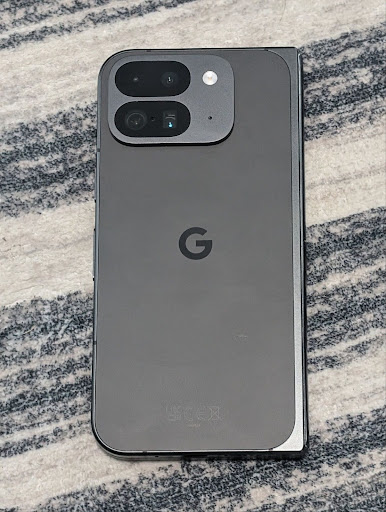
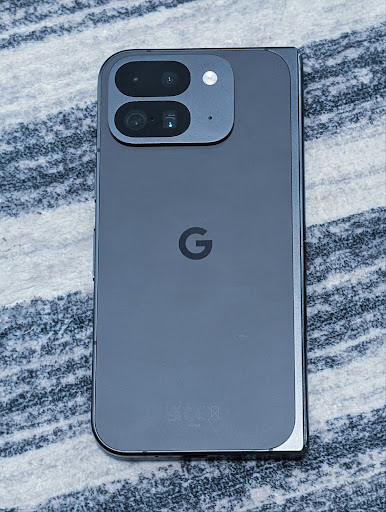
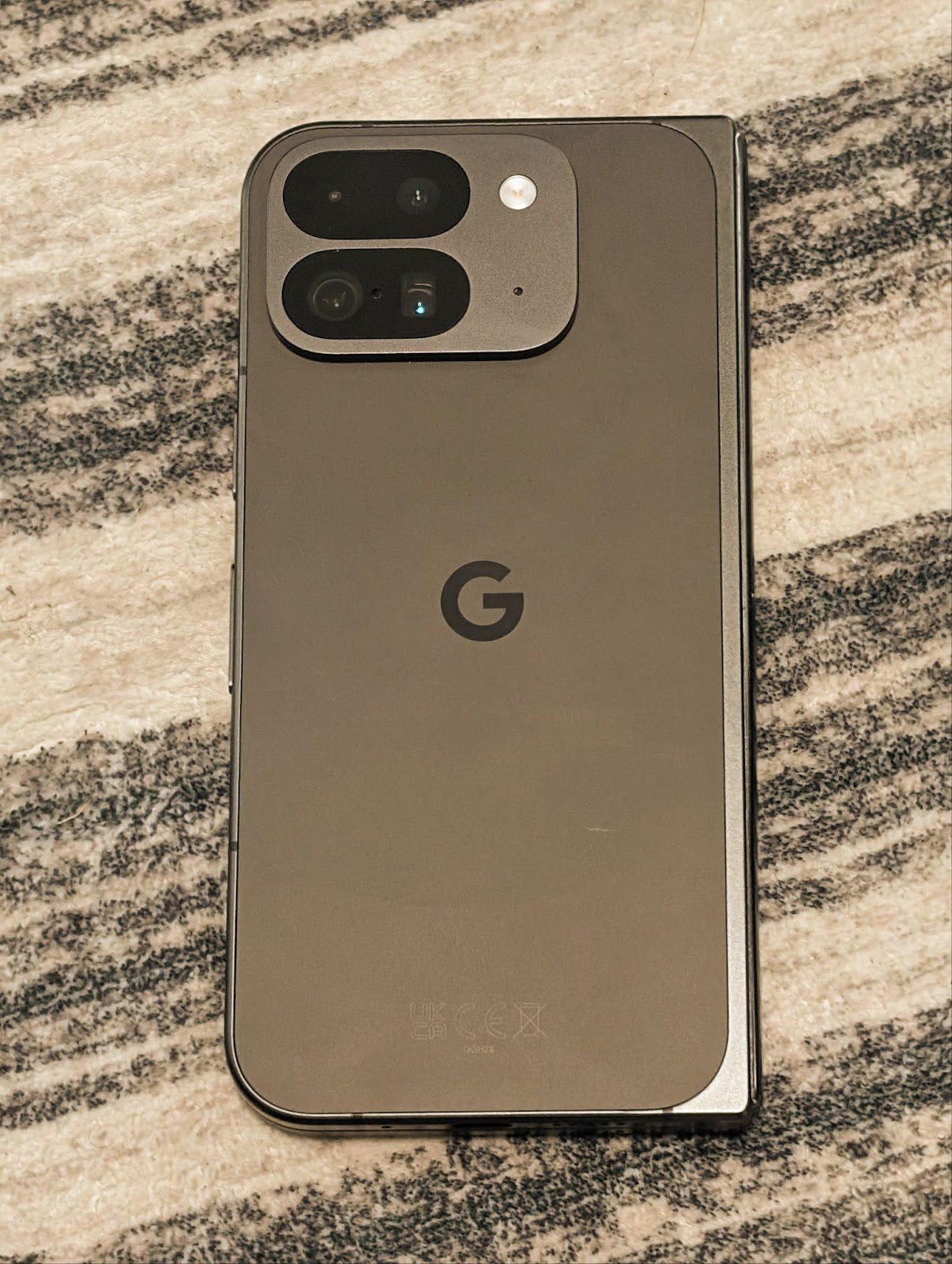
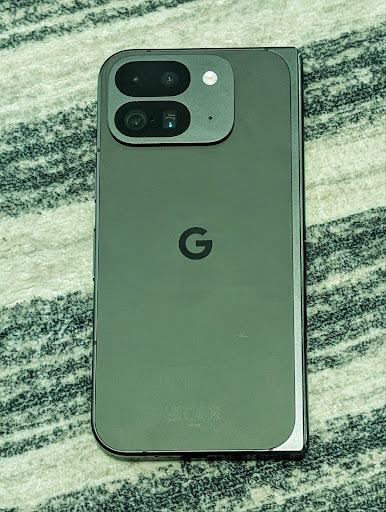
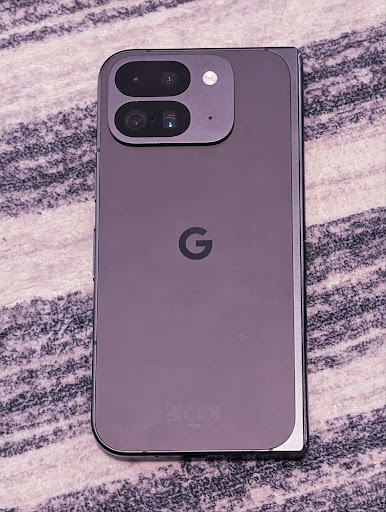
Rilevamento di scene in modalità notturna della fotocamera
Per aiutare la tua app a sapere quando passare da e a una sessione della fotocamera in modalità Notturna, Android 16 aggiunge EXTENSION_NIGHT_MODE_INDICATOR. Se supportato, è disponibile in CaptureResult in Camera2.
Si tratta dell'API che abbiamo brevemente menzionato come disponibile a breve nel post del blog In che modo Instagram ha consentito agli utenti di scattare foto straordinarie in condizioni di scarsa illuminazione. Il post è una guida pratica su come implementare la modalità notturna insieme a un caso di studio che collega le foto in modalità notturna in-app di qualità superiore a un aumento del numero di foto condivise dalla fotocamera in-app.
Azioni intent per l'acquisizione di foto in movimento
Android 16 aggiunge azioni Intent standard,
ACTION_MOTION_PHOTO_CAPTURE e
ACTION_MOTION_PHOTO_CAPTURE_SECURE, che richiedono all'applicazione della fotocamera di acquisire una foto in movimento e di restituirla.
Devi passare un EXTRA_OUTPUT aggiuntivo per controllare dove verrà scritta l'immagine o un Uri tramite Intent.setClipData(ClipData). Se non imposti un valore per ClipData, verrà copiato lì per te quando chiami Context.startActivity(Intent).
Miglioramenti delle immagini UltraHDR
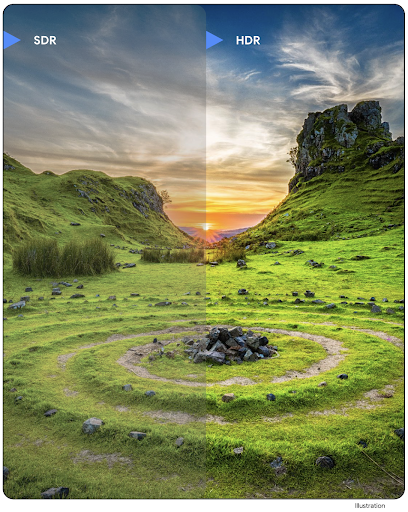
Android 16 prosegue il nostro impegno per offrire una qualità eccezionale delle immagini con le immagini UltraHDR. Aggiunge il supporto per le immagini UltraHDR nel formato di file HEIC. Queste immagini avranno il tipo ImageFormat
HEIC_ULTRAHDR e conterranno una mappa di guadagno incorporata simile
al formato JPEG UltraHDR esistente. Stiamo lavorando anche al supporto di AVIF per UltraHDR, quindi continua a seguirci.
Inoltre, Android 16 implementa in UltraHDR parametri aggiuntivi dello standard ISO 21496-1 in fase di stesura, inclusa la possibilità di recuperare e impostare lo spazio di colore in cui deve essere applicata la matematica della mappa di guadagno, nonché il supporto per le immagini di base codificate HDR con mappe di guadagno SDR.
Grafica
Android 16 include i più recenti miglioramenti grafici, come gli effetti grafici personalizzati con AGSL.
Effetti grafici personalizzati con AGSL
Android 16 adds RuntimeColorFilter and
RuntimeXfermode, allowing you to author complex effects like
Threshold, Sepia, and Hue Saturation and apply them to draw calls. Since Android
13, you've been able to use AGSL to create custom
RuntimeShaders that extend Shader. The new API
mirrors this, adding an AGSL-powered RuntimeColorFilter that
extends ColorFilter, and a Xfermode effect that
lets you implement AGSL-based custom compositing and blending between source and
destination pixels.
private val thresholdEffectString = """
uniform half threshold;
half4 main(half4 c) {
half luminosity = dot(c.rgb, half3(0.2126, 0.7152, 0.0722));
half bw = step(threshold, luminosity);
return bw.xxx1 * c.a;
}"""
fun setCustomColorFilter(paint: Paint) {
val filter = RuntimeColorFilter(thresholdEffectString)
filter.setFloatUniform(0.5);
paint.colorFilter = filter
}
Connettività
Android 16 aggiorna la piattaforma per consentire alla tua app di accedere agli ultimi progressi nelle tecnologie di comunicazione e wireless.
Rilevamento con sicurezza avanzata
Android 16 adds support for robust security features in Wi-Fi location on supported devices with Wi-Fi 6's 802.11az, allowing apps to combine the higher accuracy, greater scalability, and dynamic scheduling of the protocol with security enhancements including AES-256-based encryption and protection against MITM attacks. This allows it to be used more safely in proximity use cases, such as unlocking a laptop or a vehicle door. 802.11az is integrated with the Wi-Fi 6 standard, leveraging its infrastructure and capabilities for wider adoption and easier deployment.
API di misurazione della distanza generiche
Android 16 includes the new RangingManager, which provides
ways to determine the distance and angle on supported hardware between the local
device and a remote device. RangingManager supports the usage of a variety of
ranging technologies such as BLE channel sounding, BLE RSSI-based ranging, Ultra
Wideband, and Wi-Fi round trip time.
Contenuti multimediali
Android 16 include una serie di funzionalità che migliorano l'esperienza multimediale.
Miglioramenti al selettore di foto
The photo picker provides a safe, built-in way for users to grant your app access to selected images and videos from both local and cloud storage, instead of their entire media library. Using a combination of Modular System Components through Google System Updates and Google Play services, it's supported back to Android 4.4 (API level 19). Integration requires just a few lines of code with the associated Android Jetpack library.
Android 16 includes the following improvements to the photo picker:
- Embedded photo picker: New APIs that enable apps to embed the photo picker into their view hierarchy. This allows it to feel like a more integrated part of the app while still leveraging the process isolation that allows users to select media without the app needing overly broad permissions. To maximize compatibility across platform versions and simplify your integration, you'll want to use the forthcoming Android Jetpack library if you want to integrate the embedded photo picker.
- Cloud search in photo picker: New APIs that enable searching from the cloud media provider for the Android photo picker. Search functionality in the photo picker is coming soon.
Video professionale avanzato
Android 16 introduces support for the Advanced Professional Video (APV) codec which is designed to be used for professional level high quality video recording and post production.
The APV codec standard has the following features:
- Perceptually lossless video quality (close to raw video quality)
- Low complexity and high throughput intra-frame-only coding (without pixel domain prediction) to better support editing workflows
- Support for high bit-rate range up to a few Gbps for 2K, 4K and 8K resolution content, enabled by a lightweight entropy coding scheme
- Frame tiling for immersive content and for enabling parallel encoding and decoding
- Support for various chroma sampling formats and bit-depths
- Support for multiple decoding and re-encoding without severe visual quality degradation
- Support multi-view video and auxiliary video like depth, alpha, and preview
- Support for HDR10/10+ and user-defined metadata
A reference implementation of APV is provided through the OpenAPV project. Android 16 will implement support for the APV 422-10 Profile that provides YUV 422 color sampling along with 10-bit encoding and for target bitrates of up to 2Gbps.
Privacy
Android 16 include una serie di funzionalità che aiutano gli sviluppatori di app a proteggere la privacy degli utenti.
Aggiornamenti di Connessione Salute
Connessione Salute nella versione di anteprima per sviluppatori aggiunge ACTIVITY_INTENSITY, un nuovo
tipo di dato definito in base alle linee guida dell'Organizzazione Mondiale della Sanità sull'attività moderata e vigorosa. Ogni record richiede l'ora di inizio, l'ora di fine e l'intensità dell'attività (moderata o intensa).
Connessione Salute contiene anche API aggiornate che supportano i riepiloghi salute. In questo modo, le app possono leggere e scrivere cartelle mediche in formato FHIR con il consenso esplicito dell'utente. Questa API rientra in un programma di accesso in anteprima. Se vuoi partecipare, registrati al nostro programma di accesso in anteprima.
Privacy Sandbox su Android
Android 16 integra la versione più recente di Privacy Sandbox su Android, nell'ambito del nostro impegno continuo per sviluppare tecnologie in cui gli utenti sanno che la loro privacy è protetta. Sul nostro sito web puoi trovare ulteriori informazioni sul Programma beta per sviluppatori di Privacy Sandbox su Android per iniziare. Dai un'occhiata a SDK Runtime che consente agli SDK di essere eseguiti in un ambiente di runtime dedicato separato dall' app che stanno pubblicando, offrendo misure di salvaguardia più efficaci per la raccolta e la condivisione dei dati utente.
Sicurezza
Android 16 include funzionalità che ti aiutano a migliorare la sicurezza e proteggere i dati della tua app.
API di condivisione delle chiavi
Android 16 adds APIs that support sharing access to
Android Keystore keys with other apps. The new
KeyStoreManager class supports
granting and revoking access to keys
by app uid, and includes an API for apps to access shared
keys.
Fattori di forma del dispositivo
Android 16 offre alle tue app il supporto necessario per sfruttare al meglio i fattori di forma di Android.
Framework standardizzato per la qualità audio e video delle TV
The new MediaQuality
package in Android 16 exposes
a set of standardized APIs for access to audio and picture profiles and
hardware-related settings. This allows streaming apps to query profiles and
apply them to media dynamically:
- Movies mastered with a wider dynamic range require greater color accuracy to see subtle details in shadows and adjust to ambient light, so a profile that prefers color accuracy over brightness may be appropriate.
- Live sporting events are often mastered with a narrow dynamic range, but are often watched in daylight, so a profile that preferences brightness over color accuracy can give better results.
- Fully interactive content wants minimal processing to reduce latency, and wants higher frame rates, which is why many TV's ship with a game profile.
The API allows apps to switch between profiles and users to enjoy tuning supported TVs to best suit their content.
Internazionalizzazione
Android 16 aggiunge funzionalità e capacità che completano l'esperienza utente quando un dispositivo viene utilizzato in lingue diverse.
Testo verticale
Android 16 adds low-level support for rendering and measuring text vertically to
provide foundational vertical writing support for library developers. This is
particularly useful for languages like Japanese that commonly use vertical
writing systems. A new flag,
VERTICAL_TEXT_FLAG,
has been added to the Paint class. When
this flag is set using
Paint.setFlags, Paint's
text measurement APIs will report vertical advances instead of horizontal
advances, and Canvas will draw text
vertically.
val text = "「春は、曙。」"
Box(
Modifier.padding(innerPadding).background(Color.White).fillMaxSize().drawWithContent {
drawIntoCanvas { canvas ->
val paint = Paint().apply { textSize = 64.sp.toPx() }
// Draw text vertically
paint.flags = paint.flags or VERTICAL_TEXT_FLAG
val height = paint.measureText(text)
canvas.nativeCanvas.drawText(
text,
0,
text.length,
size.width / 2,
(size.height - height) / 2,
paint
)
}
}
) {}
Personalizzazione del sistema di misura
Users can now customize their measurement system in regional preferences within
Settings. The user preference is included as part of the locale code, so you can
register a BroadcastReceiver on
ACTION_LOCALE_CHANGED to handle locale configuration changes when
regional preferences change.
Using formatters can help match the local experience. For example, "0.5 in" in English (United States), is "12,7 mm" for a user who has set their phone to English (Denmark) or who uses their phone in English (United States) with the metric system as the measurement system preference.
To find these settings, open the Settings app and navigate to System > Languages & region.

